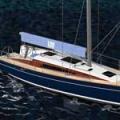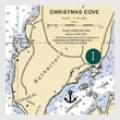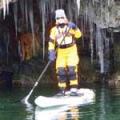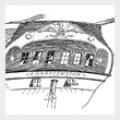Life Below the Mooring Ball
If you set it, they will come
Photos by Connie Bishop
 Parts suspended below the surface offer safety to many sessile (attached) organisms from crawling bottom-dwelling predators. The same goes for dock floats and boats not protected with antifouling paint.
Parts suspended below the surface offer safety to many sessile (attached) organisms from crawling bottom-dwelling predators. The same goes for dock floats and boats not protected with antifouling paint.
Mention the things living underwater on a typical mooring, and anyone who has had to pull a slimy mooring line onto a boat deck will respond instantly with disgust, envisioning the oozy brown slime and hand-cutting shells.
As you wipe off your glasses and sluice down everything else, pause to consider that this spray of algae and bacterial slime, along with assorted small animals, is an indicator that your boat’s mooring is a lively place.
For organisms that can’t or don’t want to swim all the time, good living space in the ocean is limited. Most objects that we put in the salt water—moorings, floats, docks, boats—are claimed (and fought over) as prime real estate. Spend a few moments to investigate further the lives of these animals and you’ll discover many interesting things.
The typical mooring consists of a large buoy attached to a chunk of granite with rope connected to a chain closer to the bottom. The buoy also is attached to a mooring pennant, which includes a smaller section of line and a small pick-up buoy. When that buoy, its line, and part of the pennant are out of the water frequently, they don’t offer favorable habitat for most species. But anyone who has picked up a mooring that’s been left untenanted for a few weeks in the summer knows it doesn’t take long for marine life to claim anything left in the water.
Parts suspended below the surface offer safety to many sessile (attached) organisms from crawling bottom-dwelling predators. The same goes for dock floats and boats not protected with antifouling paint. Pilings, wharfs, and mooring stones also offer protection from some non-swimming predators. The vertical surfaces are particularly prime, since they offer the best access to food items passing by for filter feeding animals, as well as those who wait and snatch.
 Lumpfish (Cyclopterus lumpus)
Lumpfish (Cyclopterus lumpus)
LUMPFISH: It is often possible to muckle onto the base of a mooring ball and haul it up far enough to see its underside. Carefully inspect the ball’s underwater zone for small—possibly very small—grayish baby lumpfish. If you can, gently remove one of the babies and flip it upside down. The lumpfish’s ventral (belly) fins have been modified into six pairs of flesh knobs surrounded by a circular disk of flesh, forming an effective personal suction cup. Baby lumpfish spend the summer attached to clumps of floating seaweed and other floating objects, then migrate to the bottom when winter arrives.
MUSSELS AND BARNACLES: In addition to young barnacles growing on a mooring ball, youthful blue mussels can be found clinging to the rope below. Mussels like to settle on filamentous algaes, but find rope an acceptable substitute. Mussels settled on ropes suspended in the water column grow more quickly than those in the intertidal zone since they can feed easily throughout the day, free of interruptions by predators and outgoing tides.  Stalked Tunicate / Blue Mussels (Bolteria ovifera / Mytilus edulis)
Stalked Tunicate / Blue Mussels (Bolteria ovifera / Mytilus edulis)
If you take the mooring ball and rope out of the water every winter, newly arriving free-swimming barnacle and mussel larvae (and similar settlers) find something very much to their liking in the spring: unclaimed virgin territory with no competition from older tougher relatives. Walk by any dinghy float pulled for winter and you’ll see a carpet of thousands of small blue mussels, all the same size, all the same age.
Barnacles are crustaceans, a fact that becomes clear when the upside-down, shrimplike animal inside opens its shell underwater and begins to filter feed by kicking passing food into its mouth with its feathery feet. Mussels are mollusks, like clams and scallops. They feed by siphoning in water and filtering out tiny food particles. Barnacles cement themselves in place for life. Although mussels anchor themselves with tough threads (byssus), they can move by temporarily anchoring themselves with their muscular foot then letting go of the old threads and re-attaching in a new spot. They move around quite well using this leap-frog method.
SKELETON SHRIMP: Among the mussels and seaweed you may see odd sticklike little things swaying in the current, waving tiny claws and fighting with each other. Even though they are called skeleton shrimp, and they are crustaceans, they are not actually shrimp. They belong to the amphipod family and are relatives of the little hoppers found in seaweed washed up on the beach. Their thin, jointed bodies blend into the fronds (or frond-like animals) they inhabit. Skeleton shrimp are the praying mantises of the sea, waiting patiently to snag passing prey and food items, including detritus, protists, worms, diatoms, smaller amphipods, and the larvae of other crustaceans. Skeleton Shrimp (Caprella sp.)
Skeleton Shrimp (Caprella sp.)
The relatively big (1-inch plus) skeleton shrimp found on mooring tackle, docks, boats, and other man-made floating objects is Caprella mutica, a Japanese native that has spread from East Asia throughout North America by hitching rides on ships. The indigenous species of skeleton shrimp in the Gulf of Maine are much smaller and tend be found living on seaweed and hydroids attached to rocks on the bottom. The good news is that C. mutica has so far only been found on man-made objects. The bad news is that they out-compete the native skeleton shrimp species and an unknown number of other species, and they spread easily. C. mutica colonies can reach 100,000 to 200,000 individuals per square meter. The effect they have on others isn’t necessarily only about winning a fight for space; their overwhelming numbers can cause other issues: for example, those snapping claws grab food items before they can be drawn into the mussels’ siphons.
BRYOZOANS, HYDROIDS, AND TUNICATES: Some of the things that look like algae are actually colonial animals (an association of individual organisms that are incompletely separated) including hydroids, tunicates, and bryozoans. Bryozoans are very small, and appear as unremarkable inert brownish fuzzes, branching tufts, or thin crusts. Actually, they are colonies of miniature individuals, each of which has a particular role in the colony.  Solitary Hydroid (Corymorpha pendula)
Solitary Hydroid (Corymorpha pendula)
Clumps of fluffy pink little “flowers” are tubularian hydroids, relatives of jellyfish. Hydroids also come in sticklike and branching forms. They are another good reason to wear gloves, as they capture their prey with tiny stinging tentacles, just like jellyfish. Grabbing a line covered with hydroids barehanded can be an eye-opening experience. Nudibranchs (sea slugs) eat hydroids, incorporating their victims’ stinging cells into their own bodies.
Tunicates are simple siphoning, filter-feeding animals that include the adorable sea peach, a large bottom-dwelling solitary tunicate, and the positively not adorable colonial sea squirt Didemnum vexillum. If your mooring tackle and the animals living on it are covered with dripping, pale orange, leathery snot, you have met this sheet-forming invasive species. Didemnum colonies overspread most things in their path.
 Tubularian Hydroid (Tubularia crocea)
Tubularian Hydroid (Tubularia crocea)
Foreign marine invaders like Didemnum and Capella mutica have been arriving here since ocean travel began. Some of these immigrants thrive without causing problems for the natives—the common periwinkle, for example, has been here so long that most people think it is native. Some cannot survive and disappear, and some do far better than they ever could in their home waters, to the great detriment of native marine species.
Some of the species (native and invasive) that can live on the rope and chain will appear on the mooring stone as well. Its sides offer much-desired vertical hard surfaces, and attract species that naturally favor rocks, including anemones. The advantage of living on the stone is that it is likely to stay in the water year-round; the disadvantage is that it is easily reached by bottom-dwelling predators such as starfish, predatory snails, sea slugs, crabs, and lobsters. Red Finger Aeolis (feeding on Tubularian Hydroid)
Red Finger Aeolis (feeding on Tubularian Hydroid)
Speaking of lobsters, they thrive under mooring stones. Divers who check moorings tell stories about coming facemask to stalked eyeball with lobsters that have claws as big as human hands. A lobster that size might weigh something headed for 20 pounds and be decades old.
The mooring stone and the upper tackle offer desirable habitats, but that length of heavy bottom chain can be difficult. As a moored boat swings with tides and wind, at least part of the chain drags across the bottom and can scour the area in its path clean of life. Specially designed “conservation” moorings replace the chain and stone with an anchor attached to tackle that stays clear of the bottom, allowing eelgrass and other members of the benthic community to recolonize the mooring field. Conservation moorings are now required in some harbors in Massachusetts and elsewhere, especially in areas with eelgrass beds.
While conservation moorings protect the bottom, they eliminate the habitat offered by the stone. With the idea of improving the standard granite stone for lobsters in particular, Stewart Hardison and Dr. Ian Bricknell, working with Dr. Robert Bayer of the Lobster Institute, developed the Habitat mooring, a concrete block with inviting tunnels throughout to attract lobsters. A Habitat block must be larger than a granite stone since concrete is less dense, but the mooring rig is otherwise the same from the stone up: chain, rope, buoy. Habitat blocks offer hiding places for crustaceans and fish, as well as possibly a better surface for sessile animals.
Observations of a Habitat mooring set in Seal Harbor, Maine, back in 2010 revealed more than 50 species using or visiting the block: Atlantic cod, pollock, mackerel, flounder, sculpin, cunner, lumpfish, other fish, lobsters, stone crabs, shore crabs, barnacles, sand dollars, starfish, sea urchins, orange sponge, hydroids, bryozoans, plumose anemones, sea squirts (tunicates), mussels, scallops, slipper limpets, limpets, periwinkles, sea slugs, sweet kelp, Ulva (sea lettuce), dulse, Entromorpha algae, and coralline algae.
Next time you row out to the boat, take a few minutes for a closer look at life on the dinghy dock float or your mooring. What you find is likely to be intriguing, and may also offer a useful and important window into the life and health of your home harbor.
Ruth Hill lives in Brooklin, Maine, with her husband John Brooks and their four kids. When she’s not writing about Maine natural history, she’s writing about and using glued-lapstrake wooden boats.
For More Information
Marine invasives, including those that favor man-made things like moorings, floats, and docks, are a growing threat all along the Maine coast. You can help keep an eye out for them in your home waters by participating in Vital Signs, a program of the Gulf of Maine Research Institute.
Visit the program website to sign up: vitalsignsme.org.
For more details on invasive species currently found in the Gulf of Maine or that may appear here:
Marine invasive species report for the Gulf of Maine: www.gulfofmaine.org/state-of-the-gulf/docs/marine-invasive-species.pdf. Also see “Hitchhiker’s Guide to Marine Exotic Species”: massbay.mit.edu/exoticspecies/hitchhikers/index.html.
A good book to take along on a mooring inspection field trip or to keep on the boat: Marine Life of the North Atlantic, Canada to Cape Ann; Andrew J. Martinez. (Aquaquest Publications, New York, 2003).
Getting a good look below the waterline...
It’s not easy—or even possible—to watch most of the animals living on your mooring or under the float unless you dive. The following are ways to see subtidal animals going about their daily lives.
Glass-bottomed buckets and aquascopes: You can make a simple “glass”-bottom bucket from a regular five-gallon bucket: cut a circle inside the bucket’s bottom and cut out a slightly larger Plexiglass circle. Bed (with aquarium sealer or 3M 5200 marine caulking adhesive) and screw the Plexiglass circle in the bucket. Paint the inside of the bucket black to reduce glare.
You also can buy an aquascope (available from http://www.forestry-suppliers.com or www.benmeadows.com). It’s easy to aim the aquascope in different directions and it’s long enough to use when leaning or laying over the side of a small boat or tall float.
Ropes and other enticing objects: Objects placed in the water in a manner similar to moorings and floats should attract many of the same residents. Try hanging lengths of old rope over the side of a float or tied to your mooring in such a way that you can retrieve and refasten them easily.
Last September we pulled up a short boarding ladder made of rope than had been tied to a float all season and discovered an interesting assortment of residents, including skeleton shrimp, seaweeds, and baby mussels. This coming season we plan to set a light mooring with rope bits at different depths. Some ropes and objects will be small enough to fit in a portable aquarium tank so we can immerse them and watch what their residents do while underwater.
Minus tides: It’s fun to explore the shore and tide pools during a regular low tide; it’s even better on a day when the tide is out as low as it ever goes. At the full and new moons, the tidal range is greatest; these tides are called spring tides but occur year-round. Depending on where you are along the coast, a healthy minus tide can drop a foot to two feet lower than average, exposing much more of the shore.
 Photo by Polly Saltonstall
Photo by Polly Saltonstall
Animals that spend most of their lives beneath the surface in cold water do everything they can to avoid being exposed to hot sun and wind when the tide goes out. It’s well worth it to get up for an early morning field trip on a super minus low day. This past summer we hauled our kids out of bed at five a.m. on a prime minus tide morning. There was so much to see down there, even for children who’ve grown up exploring tide pools that we had to force ourselves to head back as the tide turned and began rapidly flooding the low spot between us and dry land.
Don’t forget about man-made structures when thinking about where to go for a minus tide field trip. Pilings and stone wharves can be great places to search for sea stars, anemones, and other creatures. —RH
Related Articles
Share this article:
2023 Maine Boat & Home Show

Join Us for the Maine Boat & Home Show!
Art, Artisans, Food, Fun & Boats, Boats, Boats
August 11 - 13, 2023 | On the waterfront, Rockland, Maine
Click here to pre-order your tickets.
Show is produced by Maine Boats, Homes & Harbors magazine.















